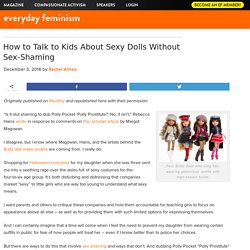

How to Talk to Kids About Sexy Dolls Without Sex-Shaming. Originally published on Ravishly and republished here with their permission.

“Is it slut shaming to dub Polly Pocket ‘Polly Prostitute?’ No, it isn’t,” Rebecca Hains wrote in response to comments on this Jezebel article by Margot Magowan. I disagree, but I know where Magowan, Hains, and the artists behind the Bratz doll make-unders are coming from. I really do. Rolling Stone's Cover Women Rarely Wear Bras. We were stoked to see Orange is the New Black’s Taylor Schilling and Laura Prepon grace the cover of Rolling Stone this month, seemingly an affirmation from the gods that feminism is on the rise.

Framed by the magazine’s cursive logo, the two are pictured braless, windblown hair flying back in tousled waves. The image is beautiful, but it was created according to a pretty sexist formula. With access to their pick of Hollywood’s most beautiful women, Rolling Stone typically shoots their cover girls in one of three ways, according to Fusion writer Kelsey McKinney: clothed, shirtless with a bra, or close-up headshot. There’s nothing new or bothersome about female nudity or the expression of sexuality, but statistics like these send a clear message to women within and outside the industry: In order to land a cover, you need to pose a certain “way.” Doing Gender with the Face, Featuring Erika Linder. By Lisa Wade, PhD, Mar 25, 2014, at 09:00 am Sociologists often say that gender is partly a performance.

How we talk and laugh and what we say; how we stand, sit, and move; how we dress, wear our hair, and adorn our faces and bodies with make up and accessories — all these things are gendered. Insofar as we follow the rule that we perform in ways that match our genitalia, male-bodied and female-bodied people will seem more different, more “opposite,” than they really are. Today I stumbled across another really striking example of gender performance. Quel âge a cette femme? Sexual Objectification, Part 1: What is it? This is Part 1 of a four-part series on sexual objectification–what it is and how to respond to it.

The phrase “sexual objectification” has been around since the 1970s, but the phenomenon is more rampant than ever in popular culture–and we now know that it causes real harm. What exactly is it, though? If objectification is the process of representing or treating a person like an object, then sexual objectification is the process of representing or treating a person like a sex object, one that serves another’s sexual pleasure. How do we know sexual objectification when we see it? Sexualization of childoohood is children’s rights issue of our time.
Just received the brand new book by Melissa Wardy of Pigtail Pals: Redfining Girly: How Parents Can Fight the Stereotyping and Sexualizing of Girlhood, from birth to Tween.

I am so excited to read this! I am a huge fan of Wardy’s company PIgtail Pals and Ballcap Buddies, and of her excellent blog, so I know this is going to be good. From the prologue: I believe that the sexualization of childhood will soon be seen as the children’s right issues of our time. Sexualization affects both boys and girls of all ages but is especially focused on our girls. TROUSSE - TCMFCQ. TROUSSE - TCMFCQ. Why Do We Sexualize Chicken? The Sexual Politics of Meat is a scathing, powerful analysis of the relationship between the oppression of women and the farming of animals for food.

Written by Carol J. Adams and published in 1990, it inspired many a feminist to choose vegetarianism and made many more take pause. In the six-and-a-half minute video below, she discusses the sexualization and feminization of chicken specifically. She shows lots of examples of the ways in which chicken carcasses are objectified as women: put in high heels, bikinis, sexual positions, etc. 2013/may/american-apparel-really-know-about-that-unisex-thing-damn-well-english-version.html. American Apparel really know about that ”unisex” thing.

Damn well. (English version) Men Need Clothes; Women Need to Look Sexy. By Lisa Wade, PhD, Aug 7, 2013, at 12:00 pm Caoileann A. sent in a great example of the way that women, but not men, are sexualized in our society.

In this case it’s a series of American Apparel ads. I know, low hanging fruit. Sex Sells, But We're Buying More Than We Bargained For. In a world where advertising-fueled media is inescapable, where the pornography industry has infiltrated all aspects of pop culture, and sexualized female bodies sell everything from children’s toys to deodorant, it’s easy to feel like sex appeal is all women can/should offer.

The truth is, this rampant sexual objectification inspires shame, anxiety, and lost potential at every turn for girls and women. But here’s something we know for sure, and it’s a message we shout from the rooftops and have proved with our PhD research: There is more to be than eye candy. And when we figure out who we are outside the confines of just being looked at, we can do so much in this world. Media shouts what we should believe about ourselves at every turn.
Halloween. 25 Inscrutable Stock Photos of Naked Women. Stock photo companies do their best to have a photo for any need, but that also means that some of the photos are so bizarre it's hard to imagine any real use for them.

A lot of them also feature unnecessary, inexplicable nudity. Here are the 25 most inscrutable stock photos of naked women. 1. Sexy and the Gender Binary. A new submission is a nice addition to this old post. The newest iteration of this gender-bending game — men in pin-up poses — can be found in the middle of this collection. Dmitriy T.M. sent in this month’s cover of GQ featuring Sasha Baron Cohen, in Bruno character. Cohen adopts a pose often used to showcase women’s bodies. Manipulated Women And High Fashion. By Lisa Wade, PhD, Apr 22, 2012, at 11:28 am I was inspired by the blog I Hurt I Am In Fashion to revive this 2008 post. This New York Times fashion slide show offers image after image demonstrating our society’s bizarre infatuation with posing women looking awkward, even deformed, frightened, compromised, uncomfortable, even in pain. I am unsure what to make, particularly, of the interest in images in which women are in dirty and uncomfortable, even painful, places and positions (see the “Maiden Voyage” spread with women in the shipyard in the NYT slide show linked to above).
Do we hate women that much? Sexual Objectification (Part 1): What is It? This is the first part in a series about how girls and women can navigate a culture that treats them like sex objects. Cross-posted at Ms., BroadBlogs, and Caroline Heldman’s Blog. Around since the 1970s and associated with curmudgeonly second-wave feminists, the phrase “sexual objectification” can inspire eye-rolling. The phenomenon, however, is more rampant than ever in popular culture. Today women’s sexual objectification is celebrated as a form of female empowerment. This has enabled a new era of sexual objectification, characterized by greater exposure to advertising in general, and increased sexual explicitness in advertising, magazines, television shows, movies, video games, music videos, television news, and “reality” television. Sexual Objectification (Part 2): The Harm. This is the second part in a series about how girls and women can navigate a culture that treats them like sex objects (see also, part One).
Cross-posted at Ms. and Caroline Heldman’s Blog. The “sex wars” of the 1980s pitted radical feminists, who claimed that female sexual objectification is dehumanizing, against feminists concerned about legal and social efforts to control and repress female sexuality. Over a decade of research now shows that radical feminists were right to be highly concerned.
Sexual Objectification (Part 3): Daily Rituals to Stop. This is the third part in a series about how girls and women can navigate a culture that treats them like sex objects. See also parts One and Two. Cross-posted at Ms. and Caroline Heldman’s Blog. This post outlines four damaging daily rituals of objectification culture we can immediately stop engaging in to improve our health. 1) Stop seeking male attention.